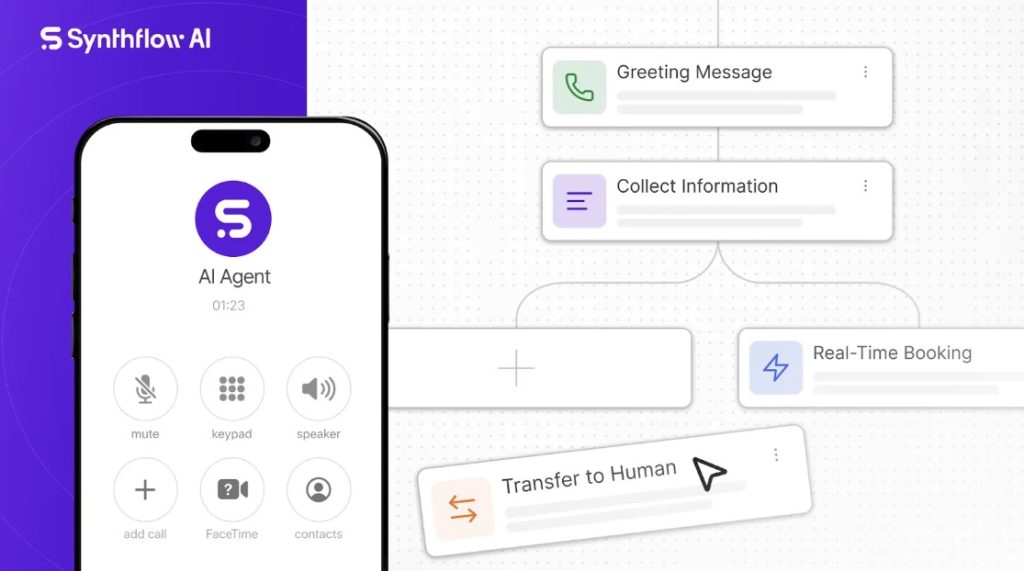Synthflow AI is a company that provides a no-code platform for building and deploying voice AI agents that automate phone calls. Pulse 2.0 interviewed Synthflow AI CEO Hakob Astabatsyan to gain a deeper understanding of the company.
Hakob Astabatsyan’s Background

What is Hakob Astabatsyan’s background? Astabatsyan said:
“I’m Hakob, co-founder and CEO of Synthflow. Before launching the company, I worked in strategy consulting at BCG and in venture building at Rocket Internet. My background is in business, but I’ve always been drawn to how emerging technologies can unlock operational efficiency and solve tough customer experience problems. That curiosity—and a strong belief in what voice AI could become—is what led me to co-found Synthflow with my two partners, Albert and Sasun, in early 2023.”
Formation Of The Company
How did the idea for the company come together? Astabatsyan shared:
“The idea came together shortly after OpenAI released a major version of GPT via API. We were fascinated by its potential, but also knew it needed a better interface – especially for business users. We began by building a no-code layer on top of GPT for text. Pretty quickly, though, we realized the real frontier was voice.”
“Voice is inherently harder than text – latency, interruptions, timing – all of it matters more. Early on, our latency was over one second, and the experience felt clunky. But we fell in love with the challenge. That’s when we pivoted fully into voice, and Synthflow, as it exists today, took shape. We launched the current version in the summer of 2023 and never looked back.”
Favorite Memory
What has been your favorite memory working for the company so far? Astabatsyan reflected:
“There are a few, but one that stands out is launching our first working voice agent after 6–8 months of intense development. It could answer questions, schedule appointments, and transfer calls – with low latency and human-like tone. That was also our first month with revenue, and it felt like the beginning of something real.”
“Another big moment was reaching 5 million calls per month. That volume gave us the data to iterate fast and mature the platform to an enterprise-ready level – while we were still a 20-person team. That speed and focus is something I’m very proud of.”
Core Products

What are the company’s core products and features? Astabatsyan explained:
“Synthflow is a voice AI platform that helps businesses automate phone conversations—both inbound and outbound—without requiring a large engineering team. Our main product is a no-code voice agent builder that lets teams create intelligent call flows, connect to their existing systems, and go live in under three weeks. The agents can answer calls, schedule appointments, qualify leads, send follow-up texts, and transfer to human reps when needed. Under the hood, we’ve built a highly reliable infrastructure with sub-500ms latency, which is critical for natural conversations. We also support over 50 languages and offer voice cloning to match a company’s tone and brand. For enterprises, we provide built-in compliance with HIPAA, SOC 2, and GDPR, along with flexible telephony options like SIP trunking and BYOC. Everything is designed to be fast to deploy, deeply customizable, and scalable from pilot to production.”
Challenges Faced
What challenges have Astabatsyan and the team faced in building the company? Astabatsyan acknowledged:
“Voice AI comes with a unique set of challenges, especially in the enterprise space. The biggest one early on was getting the user experience right. Voice needs to feel personal – people are far less forgiving of awkward pauses or robotic phrasing than they are with chat. We had to solve for latency, interruption handling, and audio quality all at once, and it took real engineering focus to get there.”
“Another ongoing challenge has been cutting through the noise. There has been a wave of interest in generative AI, but in practice, many companies struggle to know where to start or have been disappointed by tools that are too rigid or difficult to scale. We overcame that by leaning into accessibility. We made Synthflow no-code, API-friendly, and fast to deploy. That clarity, combined with live customer pilots, has helped us stand out and build trust, even in a crowded market.”
Significant Milestones
What have been some of the company’s most significant milestones? Astabatsyan cited:
“Launching our first production-ready voice agent was a turning point. It marked the moment we moved from experimentation to real-world value, handling live customer calls, driving outcomes, and generating revenue. From there, things accelerated quickly. We’ve raised a total of $29 million in funding, including a $20 million Series A, and have scaled to over five million calls per month.”
“One of the clearest indicators of product-market fit has been retention. Today, we maintain over 90% retention among enterprise customers. These are companies that don’t just test Synthflow—they build around it. Many started with a single use case and now run hundreds of AI agents across support, scheduling, and sales workflows. That kind of expansion, driven by results, is what we’re most proud of.”
Customer Success Stories
When asking Astabatsyan about customer success stories, he highlighted:
“Definitely. One example is Medbelle, a healthcare company operating in the UK and Germany. They came to us with a classic scheduling bottleneck—too many inbound appointment requests and not enough staff to handle them efficiently. Within weeks of launching Synthflow, they increased scheduling efficiency by over 60%, doubled their number of qualified appointments, and cut no-show rates by 30%. It wasn’t just automation—it was measurable improvement to patient access and operational load.”
“Another case is Smartcat, a global AI platform in the translation space. They used Synthflow to automate their outbound SDR campaigns. The results were impressive: a 70% reduction in demo booking costs, a 24% increase in answered calls, and a 15% bump in closed sales. In both cases, the success wasn’t about replacing people—it was about freeing teams up to focus on higher-value work while AI handled the repetitive conversations.”
Funding
When asking Astabatsyan about the company’s funding details, he revealed:
“We’ve raised $29 million so far, backed by some of the top investors in AI and enterprise SaaS. Our most recent round was a $20 million Series A, which we’re using to accelerate product development and expand in the U.S. and Western Europe. We’ve seen 15x revenue growth since our launch and now handle more than five million voice calls every month. While we’re not sharing exact revenue numbers publicly yet, the business fundamentals are strong—our retention among enterprise customers is over 90%, and we’re seeing consistent expansion from pilot to scale.”
Total Addressable Market
What total addressable market (TAM) size is the company pursuing? Astabatsyan assessed:
“We’re focused on the enterprise voice automation market, which we estimate at over $50 billion today. If you zoom out, trillions of dollars still flow through phone-based customer interactions every year—whether it’s support, scheduling, sales, or service. Voice hasn’t gone away—it just hasn’t been modernized. We’re starting with high-volume verticals where the need for scale, reliability, and cost efficiency is urgent. Over time, we see Synthflow powering millions of AI voice agents across industries, automating everything from the first touchpoint to complex operational workflows.”
Differentiation From The Competition
What differentiates the company from its competition? Astabatsyan affirmed:
“We’re laser-focused on making voice automation work at scale for enterprises. That means fast deployment, low latency, deep integrations, and bulletproof reliability. Most competitors take months to launch, require custom engineering, or force you into rigid setups. With Synthflow, teams can go live in under three weeks using a no-code builder or our full API suite, all while staying compliant with SOC 2, HIPAA, and GDPR.”
“We’re also LLM-native, built from the ground up for this wave of AI—not patched onto legacy IVR tech. That gives us a clear edge when it comes to real-time responsiveness, multi-turn conversations, and interruption handling. And critically, we’ve engineered our infrastructure to stay live when others go down. Synthflow is multi-cloud by design, with automatic failover, health checks, and redundancy across compute, telephony, storage, and inference. So when there’s an outage—at OpenAI, Google Cloud, anywhere—our customers stay online. That level of resilience isn’t a feature for us. It’s the baseline.”
Future Company Goals
What are some of the company’s future goals? Astabatsyan emphasized:
“We’re focused on deepening the platform to support more complex, enterprise-scale voice automation. That includes rolling out features like custom evaluations to assess agent performance, persistent memory for context continuation across calls and agents, a real-time analytics dashboard for visibility into every conversation, multi-location routing to support national and distributed teams, and WhatsApp call support to expand beyond traditional voice channels. These additions are all part of our broader goal: to give businesses full-stack control over how voice AI fits into their operations.”
“Longer term, we’re building toward a future where every repetitive phone conversation—whether it’s inbound, outbound, or multi-channel—is handled by AI. We want Synthflow to be the most reliable, flexible, and scalable voice automation platform on the market, with the infrastructure to support millions of agents running in parallel across industries, regions, and languages. We’re not chasing hype—we’re building something that lasts.”
Additional Thoughts
Any other topics you would like to discuss? Astabatsyan concluded:
“We’ve been automating for years—emails, support tickets, internal workflows. But my voice was left behind. And now that voice AI is finally catching up, the first reaction from many people is fear: ‘Great, more spam calls.’ Or, ‘Is this going to replace human jobs?’”
“I get it. We’ve all experienced the worst version of automation—irrelevant, scripted, robotic. But that’s not what we’re building at Synthflow. Not even close.”
“We’re not here to flood people with spam or take jobs away. Synthflow doesn’t power robocalls or mass sales blasts. It powers real, useful conversations—like helping someone reschedule an appointment, get support when the office is closed, or quickly confirm an insurance detail. And it’s not about replacing humans. It’s about giving teams relief from the repetitive calls they shouldn’t have to take in the first place—so they can spend more time where it actually matters: helping people, solving problems, and doing work that requires a human touch.”
“So no, we’re not building more calls. We’re building better ones. And we believe voice AI, done right, doesn’t create distance. It brings businesses closer to their customers—faster, more reliably, and at scale.”


